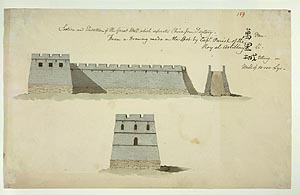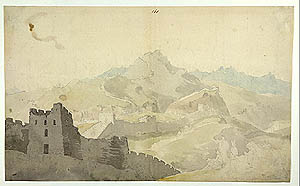| |
 |
| |
| Topics & News |
|
The Lion and The Dragon
By Rocketman
 In order to expand its trade in the Far East, Great Britain set up its liaison office in China in 1795. Some of the office staff wrote in great detail about the things they witnessed in old China carrying out research on China's social, economic and military affairs, as well as the historical relics. All this material was later included in a book called The Lion and The Dragon, published in Europe. Among these stories are some chapters devoted to the Great Wall, which also include three pictures. The first of these is a sketch showing a detail of the inner structure of a two-story watchtower at the Gubeikou Great Wall in Beijing. This watchtower still stands today. The second is a sketch showing a typical structure of the wall. The articles and two sketches are by an Englishman Lieutenant Parish. His friend, the artist William Alexander who spent two years in Beijing as draughtsman for the British Embassy was very interested in the wonders of the orient. He painted several watercolors of the Great Wall, including the third picture shown below, with the aid of Parish's descriptions and sketches. In order to expand its trade in the Far East, Great Britain set up its liaison office in China in 1795. Some of the office staff wrote in great detail about the things they witnessed in old China carrying out research on China's social, economic and military affairs, as well as the historical relics. All this material was later included in a book called The Lion and The Dragon, published in Europe. Among these stories are some chapters devoted to the Great Wall, which also include three pictures. The first of these is a sketch showing a detail of the inner structure of a two-story watchtower at the Gubeikou Great Wall in Beijing. This watchtower still stands today. The second is a sketch showing a typical structure of the wall. The articles and two sketches are by an Englishman Lieutenant Parish. His friend, the artist William Alexander who spent two years in Beijing as draughtsman for the British Embassy was very interested in the wonders of the orient. He painted several watercolors of the Great Wall, including the third picture shown below, with the aid of Parish's descriptions and sketches.

[1]

[2]

[3]
Gubeikou Great Wall is located in the southeast of Gubeikou Village, Miyun County. It was first constructed in the Qi Dynasty (479~502). An important pass was built here in the Tang Dynasty (618-907). Owing to its location at the mountain name Wohu (Sleeping Tiger), it was first called Hubeikou. During the early Ming Dynasty, a city was established at the pass. Called Gubeikou, the city was two kilometers in perimeter and had gates in the eastern, southern and northern walls. The city remains well preserved today.
|
| |
|

